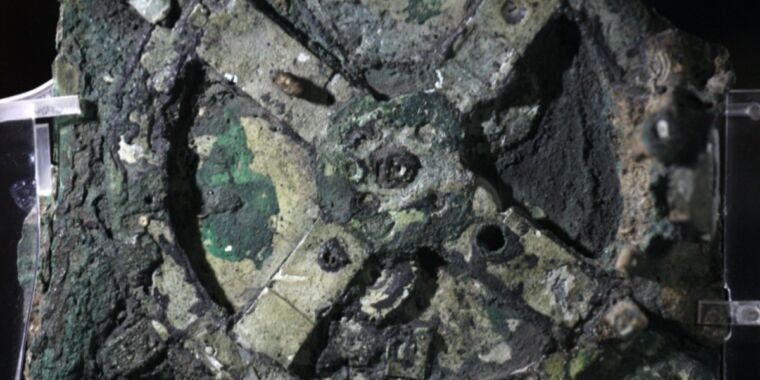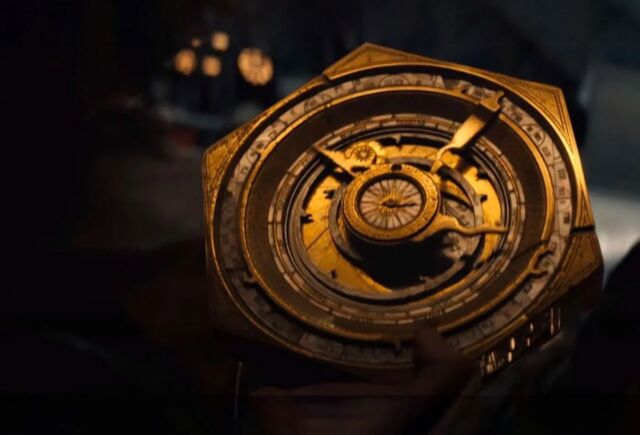New Antikythera mechanism analysis challenges century-old assumption

Fine Art Images/Heritage Images/Getty Image
The inspiration for the titular device in last year’s blockbuster, Indiana Jones and the Dial of Destiny, was an actual archaeological artifact: the Antikythera mechanism, a 2,200-year-old bronze mechanical computer. It doesn’t have any mystical time-traveling powers, but the device has been the subject of fierce scientific scrutiny for many decades and is believed to have been used to predict eclipses and calculate the positions of the planets.
A new paper published in The Horological Journal found evidence, based on statistical techniques drawn from physics, particularly the study of gravitational waves, that the mechanism’s calendar ring was designed to track the lunar calendar. This contradicts a century-long assumption among scholars of the mechanism that the calendar ring had 365 holes, thus tracking with a solar calendar, but is in keeping with the conclusions of a 2020 analysis.
“It’s a neat symmetry that we’ve adapted techniques we use to study the universe today to understand more about a mechanism that helped people keep track of the heavens nearly two millennia ago,” said co-author Graham Woan, an astrophysicist at the University of Glasgow. “We hope that our findings about the Antikythera mechanism, although less supernaturally spectacular than those made by Indiana Jones, will help deepen our understanding of how this remarkable device was made and used by the Greeks.”
As previously reported, a Greek sponge diver named Elias Stadiatis discovered the wreck of an ancient cargo ship in 1900 off the coast of Antikythera Island in Greece. He and other divers recovered all kinds of artifacts from the ship. A year later, an archaeologist named Valerios Stais was studying what he thought was a piece of rock recovered from the shipwreck when he noticed that there was a gear wheel embedded in it. It turned out to be an ancient mechanical device. The Antikythera mechanism is now housed in the National Archaeological Museum of Athens.
In 1951, a British science historian named Derek J. de Solla Price began investigating the theoretical workings of the device. Based on X-ray and gamma-ray photographs of the fragments, Price and physicist Charalambos Karakalos published a 70-page paper in 1959 in the Transactions of the American Philosophical Society. Based on those images, they hypothesized that the mechanism had been used to calculate the motions of stars and planets—making it the first known analog computer.

Disney/Lucasfilm
Michael Wright, then curator of mechanical engineering at the Science Museum in London, made headlines back in 2002 with new, more detailed X-ray images of the device taken via linear tomography. Wright’s closer analysis revealed a fixed central gear in the mechanism’s main wheel, around which other moving gears could rotate. He concluded that the device was specifically designed to model “epicyclic” motion, keeping with the ancient Greek notion that celestial bodies moved in circular patterns called epicycles. (This was pre-Copernicus, so the fixed point around which they moved was believed to be the Earth.)
In 2021, an interdisciplinary team at University College London (UCL) led by mechanical engineer Tony Freeth, an honorary professor at University College London, introduced a new computational model, revealing a dazzling display of the ancient Greek cosmos. The team’s efforts built on Wright’s work as part of the ongoing Antikythera Mechanism Research Project, which undertook more advanced 3D X-ray imaging with the help of X-Tek Systems in the UK and Hewlett-Packard, among others. Those images revealed much more of the original Greek transcription, confirming it was an astronomical computer used to predict the positions of heavenly bodies in the sky. It’s likely that the Antikythera mechanism once had 37 gears, of which 30 survive, and its front face had graduations showing the solar cycle and the zodiac, along with pointers to indicate the positions of the Sun and Moon.
Source link




